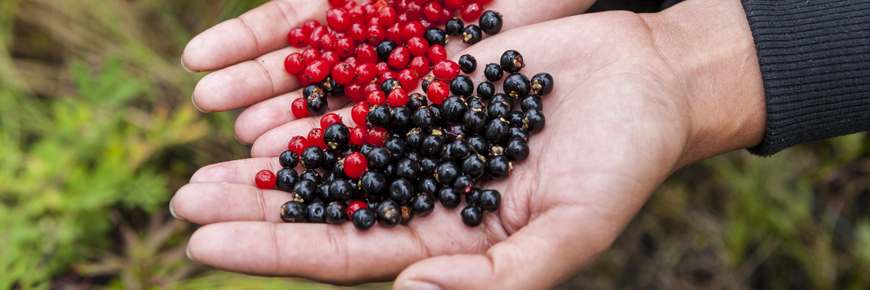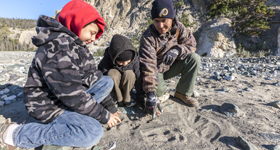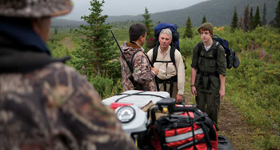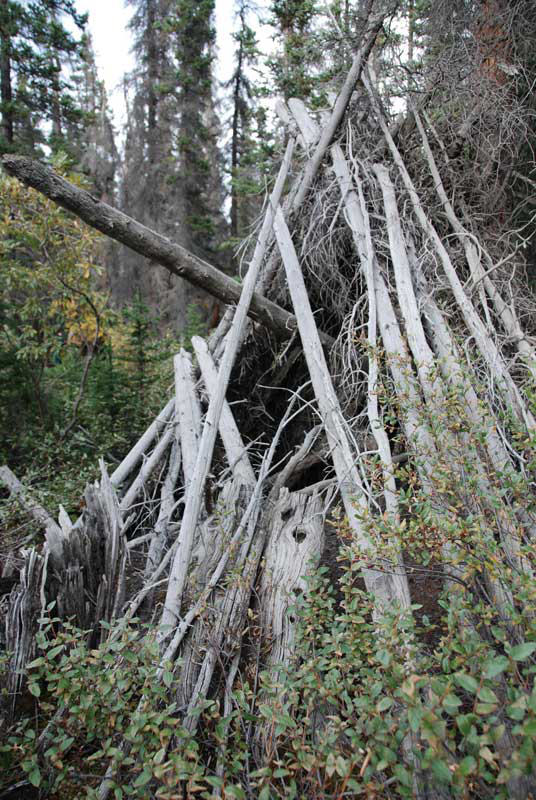
Harvesting activities - visitor information
Kluane National Park and Reserve
First Nation Harvesting Rights | Background | Recreation and Harvesting Rights | Heritage Resources | Frequently Asked Questions | Contact Information
Printable Version
You can download the information found on this web page in PDF format.
- Harvesting Activities - Visitor Information
(PDF, 7.83)
First Nation Harvesting Rights
Dännch’e / Welcome

Welcome to Kluane National Park and Reserve (KNPR). This area is part of the traditional territory of the Champagne and Aishihik First Nations (CAFN), and Kluane First Nation (KFN) and continues to be highly valued for its abundance and diversity of northern plant and fish and wildlife populations. Harvesting plants and animals for food, medicine and ceremonial purposes has long sustained the local indigenous peoples of Kluane and today remains a vital part of their culture. Today, KNPR is managed cooperatively with CAFN and KFN.
Citizens of these two First Nation governments maintain a deep cultural and spiritual connection to the lands now within the park. They are key partners in the management and conservation of natural and cultural resources in KNPR. This information is intended to inform visitors about the harvesting rights of CAFN and KFN citizens within KNPR.
For more detail, please consult the appropriate First Nation’s Final Agreement.
Background
Nän käy shäwthǟn uk’ats’änáta - The earth, take care of it
For thousands of years, Dän (indigenous people) pursued a subsistence-hunting and gathering lifestyle throughout much of the region now called Kluane National Park and Reserve (KNPR). In 1943, the federal government set aside this area as a game sanctuary to protect wildlife in the area, a move that also effectively banned First Nations from hunting and trapping and pursuing their subsistence lifestyle. Prohibiting subsistence harvesting by the area’s indigenous peoples has had serious and lasting effects on First Nations’ culture and livelihoods, as well as the region’s ecosystem. A portion of the Kluane Game Sanctuary became what is now Kluane National Park and Reserve in 1973. Parks Canada recognizes that First Nation harvesting is an integral part of the ecological integrity of Kluane National Park and Reserve and the greater Kluane region. Now, a renewal of First Nations subsistence harvesting within the park is helping to restore the relationship between First Nations and their environment.

The recognition of aboriginal peoples’ rights to harvest within the Kluane Game Sanctuary (and later the park) was not easily achieved. Not until 1993 did CAFN finally receive legislated assurance, through a comprehensive agreement, that they could return to their traditional lands in the Kluane area and resume harvesting in the park. In 2003, KFN also negotiated a comprehensive agreement confirming similar rights.
During negotiations, all parties (CAFN, KFN and Canadian government) expressed concerns related to conservation and public health and safety, and were recognized as essential in maintaining the natural and cultural environment. These principles have been adopted by all parties, and remain key principles in managing First Nations subsistence harvesting activities.
The Constitution of Canada has recognized and affirmed the existing aboriginal and treaty rights of aboriginal peoples of Canada. This includes rights that now exist by way of land claims agreements or may be so acquired – The Constitution of Canada, 1982 s.35
Recreation and Harvesting Rights

If you are visiting KNPR, be aware that First Nations may be exercising their subsistence harvesting rights in the park. You may encounter harvesting activities anywhere in KNPR, and at any time of the year, but this is more likely between June and October. CAFN and KFN citizens have rights to use both traditional and current tools and methods to engage in subsistence harvesting within KNPR, which may include the use of snowmobiles and ATVs. In the event that you do encounter any signs of harvesting activities during your visit, please be respectful of First Nations harvesting rights and follow these guidelines:
- If you see harvesting activities taking place in the park, exercise caution and use your best judgement to determine if the harvester is aware of your presence. You may decide to make yourself known to harvesters by waving or calling out. Alternatively, you may also decide to just leave the area if it is safe to do so. Please keep in mind that a harvester could be stalking wildlife and noise may scare their quarry away:
- Please don’t interfere with any harvesting activities. Be considerate, polite, and courteous of other users and allow them to carry out their activities in a respectful manner;
- Only approach subsistence harvesters if you are invited and remember that some people may feel uncomfortable with visitors observing them;
- Always ask the harvester for permission before taking any video or photographs of harvesting activities.
Heritage Resources
A Land Rich in History, A Land That Provides
First Nations have occupied this landscape for time immemorial. As a result, there are numerous historic sites and artifacts in the park. Common types of heritage sites and signs that can be found in KNPR include:

- Brush houses, brush shelters and drying racks
- Trail blazes/markers
- Cabins, caches and dog houses
- Campsites with old pots, pans, traps and mining equipment
- Archaeological sites with stone tools scarpers, spear points, etc.) and flakes left behind when making stone tools
- Evidence of old fireplaces (cracked rocks, small fragments of cooked bone)
- Piles of rocks covered with lichen (especially in the high subalpine country), indicating hunting blinds, caches, or trails/routes.
Heritage sites in the park are protected and are not to be disturbed. Please respect these sites by leaving them in the same condition as they are found. Do not collect artifacts, burn stumps or wooden structures or remains. If you see something unusual, please report it to KNPR staff and if possible GPS the site and take images of the location.
Please remember that this is the homeland of CAFN and KFN and their presence on the land forms a vital part of the park’s ecological integrity. Parks Canada recognizes that the First Nations of this region are integral to a functioning and healthy ecosystem.
Frequently Asked Questions
1. What harvest activities will I encounter?
Common harvesting activities in Kluane National Park and Rerserve (KNPR) include hunting, trapping, fishing, or gathering plants for food and medicine as well as any travel and camping associated with harvesting activities.
2. Are there any places where I can travel where harvesting activities are not allowed?
The entire area within the boundary of KNPR that falls within Champagne and Aishihik First Nations (CAFN) and Kluane First Nation (KFN) traditional territories can be utilized for harvesting. There are three No Harvest Zone’s (NHZ) located in the Ä’äy Chù Valley and Thachäl Dhǟl (see Map). However there are special circumstances that allow for First Nation harvest to occur within these NHZ’s as well.
First Nations harvesting activities are less likely in those areas of KNPR where there is less fish, wildlife, or plants, such as the icefields. CAFN members are asked to observe a Voluntary No Firearms Discharge Zone within a 1 km of the Kathleen Lake Campground.
3. Who can I contact to report a problem or to ask questions?
Contact Kluane National Park and Reserve in Haines Junction for general questions and information. Contact the Resource Conservation and Park Warden office for matters related to law enforcement, or to report a kill site. All contact information is provided at the end of this brochure.
4. Is it possible to know ahead of time, what harvest activities are taking place and where?
No, it is not always possible. Visitors to the park will be told if there are any planned harvesting activities in the area; however, as harvesting often occurs opportunistically or spontaneously, this is not always possible. First Nations harvesting occurs as needed throughout the year and when resources are available, but the majority of harvesting is between June and October.
5. What happens if I run across a kill site?
In the event that you do encounter a kill site with gut pile remains (entrails), leave the area immediately and report the location to parks staff as soon as possible. Animal remains can attract bears and other scavenging animals and the area can be very dangerous.
6. Can I approach a harvester with a kill to help or to watch?
If you encounter a harvester who is field dressing game, make yourself known to the harvester, respect the harvester’s space needed to safely field dress the game, and approach only if invited by the harvester. Again, only take pictures or video if the harvester gives you permission.
7. What First Nations are allowed to harvest? How can I tell?
Citizens of Champagne and Aishihik First Nations (CAFN) and Kluane First Nation (KFN) have the legal right to harvest in their respective traditional territories within KNPR (See map). Only Park Wardens and other enforcement officers are allowed to ask for identification from First Nations harvesters in KNPR. Please contact the Park Wardens if you have any concerns regarding harvesting activities in KNPR.
8. How can I know that I am safe?
First Nation harvesters are experienced hunters and follow safe hunting practices. Generally, hunters tend to avoid areas with high visitor traffic as wildlife is also likely to avoid these areas as well. Following the same safety precautions as you would for travelling in bear country and for wilderness safety (i.e. making noise, wearing bright colors) will help ensure your safety when pursuing recreational activities in KNPR.
9. Can I ask a First Nations harvester what they are doing?
This depends on the individual harvester and can vary with the situation. As a general guideline, make yourself known to the harvester and approach a harvester only if you are invited to do so. If there is no communication with the harvester(s) please continue on your journey.
10. Can a harvester be working as a commercial guide?
First Nations harvesting rights in KNPR is for subsistence purposes only and guiding hunters is prohibited within KNPR. Other forms of commercial guiding require a Parks Canada Business and Guiding license.
11. Can a First Nations harvester sell what they harvest in KNPR?
First Nations harvesting in KNPR is for subsistence use and may be shared, traded, or sold among other Yukon First Nations for domestic use. However, any furs or handicrafts such as moccasins or other items made from animal, plant, or other natural products harvested in KNPR, may be sold to the general public.
12. What is being done to ensure healthy species populations are being maintained?
The Minister of Environment has the authority to impose harvest limits, including allowable harvests and seasons for harvesting. KNPR has an extensive environmental monitoring program tracking the numbers and health of different plant and animal populations in the park. If a population goes beyond an established threshold, KNPR will work with CAFN, KFN, and the Kluane Park Management Board to address the issue.
13. How will the public be notified of management changes to zones or management actions?
The Kluane Park Management Board and KNPR will communicate significant changes through the Parks Canada website, local media, Parks Canada brochures, and signs/notices at trailheads and at the two KNPR Visitor Centers. You can always call the park to get the status of any trail closures or travel advisories before you arrive.
Contact Information
Please contact the appropriate office for further information related to harvesting, for help planning your recreational activities in Kluane National Park and Reserve, or to report a kill site or law enforcement incident.
Kluane National Park and Reserve
119 Logan Place
P.O. Box 5495
Haines Junction, Yukon Y0B 1L0
Phone (867) 634-7250
Visitor Center Front Desk (867) 634-7207
Fax (867) 634-7208
Resource Conservation & Park Warden
Law Enforcement Branch
P.O. Box 5495
Haines Junction, Yukon Y0B 1L0
Phone (867) 634-7279
24-Hour Emergency Dispatch (877) 852-3100
Fax (867) 634-2043
The information on this web page was a joint initiative developed in co-operation by Champagne and Aishihik First Nations, Kluane First Nation, Kluane National Park & Reserve, and Kluane Park Management Board.
Related links
- Date modified :
